Podcast
Questions and Answers
What is another term for primary storage?
What is another term for primary storage?
- Primary memory (correct)
- Backup storage
- Tertiary storage
- Secondary memory
Which component is known as the central nervous system of the computer?
Which component is known as the central nervous system of the computer?
- Arithmetic Logic Unit (ALU)
- Input Unit
- Memory Unit
- Control Unit (CU) (correct)
What is the first step in the data processing cycle?
What is the first step in the data processing cycle?
- Data storage
- Data collection (correct)
- Data analysis
- Data transmission
What does data processing primarily involve?
What does data processing primarily involve?
Which of the following is NOT a type of primary storage?
Which of the following is NOT a type of primary storage?
What determines the quality of output in data processing?
What determines the quality of output in data processing?
Which method is NOT typically involved in data processing?
Which method is NOT typically involved in data processing?
Which type of storage is typically used for backup purposes?
Which type of storage is typically used for backup purposes?
What is the fastest storage device closest to the CPU?
What is the fastest storage device closest to the CPU?
Where are final results sent after processing before outputting?
Where are final results sent after processing before outputting?
Which of the following devices is NOT an input unit?
Which of the following devices is NOT an input unit?
Which component manages and coordinates the entire computer system?
Which component manages and coordinates the entire computer system?
What are the basic functions of a computer system?
What are the basic functions of a computer system?
What is one primary reason PCs are said to have changed our lives significantly?
What is one primary reason PCs are said to have changed our lives significantly?
What is meant by data after it has been processed and is useful?
What is meant by data after it has been processed and is useful?
What is the term for the electronic circuitry that manipulates data to produce information?
What is the term for the electronic circuitry that manipulates data to produce information?
Which of the following is NOT a component of a computer system?
Which of the following is NOT a component of a computer system?
How do different components of a computer interact with each other?
How do different components of a computer interact with each other?
What do we call the data needed for processing?
What do we call the data needed for processing?
What is the foundational concept behind data processing in a computer?
What is the foundational concept behind data processing in a computer?
Which of the following is classified as a direct entry input device?
Which of the following is classified as a direct entry input device?
Which component of a computer is primarily responsible for sending and receiving data?
Which component of a computer is primarily responsible for sending and receiving data?
What is the primary function of the ALU in a computer system?
What is the primary function of the ALU in a computer system?
What is an important aspect of understanding computer components?
What is an important aspect of understanding computer components?
Which of the following best describes soft copy output?
Which of the following best describes soft copy output?
When data and instructions are entered into a computer, where must they be stored before processing?
When data and instructions are entered into a computer, where must they be stored before processing?
What is the role of storage devices in a computer?
What is the role of storage devices in a computer?
Why is it essential to analyze how each component processes data?
Why is it essential to analyze how each component processes data?
What distinguishes hard copy output from soft copy output?
What distinguishes hard copy output from soft copy output?
Which of the following is NOT a function of the output unit?
Which of the following is NOT a function of the output unit?
What is the role of intermediate results in the processing unit?
What is the role of intermediate results in the processing unit?
Which device is considered an indirect entry input device?
Which device is considered an indirect entry input device?
Which of the following best describes the function of input devices in a computer system?
Which of the following best describes the function of input devices in a computer system?
What is the primary role of output devices in computer systems?
What is the primary role of output devices in computer systems?
Which of the following devices would be considered an indirect entry input device?
Which of the following devices would be considered an indirect entry input device?
What does the data processing cycle primarily involve?
What does the data processing cycle primarily involve?
In a computer system, how does a processing device function in relation to input and output devices?
In a computer system, how does a processing device function in relation to input and output devices?
Which of the following statements is true regarding system software?
Which of the following statements is true regarding system software?
Which of the following represents a memory device in a computer system?
Which of the following represents a memory device in a computer system?
Which input device would typically be used for complex data entry directly from documents?
Which input device would typically be used for complex data entry directly from documents?
Flashcards are hidden until you start studying
Study Notes
Introduction to Computer Components
- Personal Computers (PCs) have significantly transformed daily tasks and society.
- The increasing complexity of computer operations often overwhelms users.
- Understanding computer components is essential for beginners to grasp their utility and functionality.
Objectives of the Lesson
- Explain operations and functions of computer components.
- Describe different types of components: input, output, system unit, storage, and communications devices.
- Analyze how each component processes data.
- Explore human interaction with computers and their usefulness.
Input Devices
- Input devices facilitate data entry into a computer system.
- Examples include keyboard, mouse, scanners, and microphones.
- Direct Entry Input Devices send data to the CPU without further encoding (e.g., scanners).
- Indirect Entry Input Devices (e.g., keyboard) require data encoding for CPU understanding.
Processing Unit
- The Arithmetic and Logical Unit (ALU) is responsible for performing calculations and comparisons.
- It executes instructions during processing and can store intermediate results in memory.
- After processing, final results are transmitted to storage units for safekeeping.
Output Devices
- The output unit takes processed information from the CPU and presents it to the user.
- Output is initially in binary form, which gets decoded into a usable format.
- Soft output devices (e.g., monitors, speakers) provide temporary results, while hard copy devices (e.g., printers) create permanent outputs.
Storage Devices
- Data and instructions must be stored before processing can begin.
- Storage units hold processed results and intermediate data temporarily or permanently.
- Storage devices can be internal (within the main computer) or external (external to the main computer).
- Primary storage (e.g., RAM, cache) is essential for immediate data access, while secondary storage serves as backup (e.g., magnetic disks, optical disks).
Controlling Unit
- The Control Unit (CU) directs the overall operations of the computer system.
- It manages the execution of programs and coordinates the functions of the CPU.
- Although the CU does not perform data processing, it ensures order in operations, similar to a nervous system.
Data Processing Cycle
- Data processing involves a systematic cycle transforming raw data into meaningful information.
- Stages include data collection, input, processing, output, and storage.
- The quality of data collected significantly impacts the quality of output.
Data Collection
- Gathering data from various sources is the first step in the cycle, critical for reliable outcomes.
- Methods include using primary data (first-hand collected) and secondary sources (existing data).
- Examples of data collected might include census information, GDP data, and industry statistics.
Key Terminology
- Data: Raw facts and figures collected for processing.
- Information: Processed data that has meaning and value.
- Computer System: Comprises hardware, software, humanware (people), and dataware (data).
- Northbridge and Southbridge: Components that manage communication between CPU and other parts.
Interaction with Computers
- Even powerful supercomputers rely on human interactions for effective operation.
- Understanding the roles and functions of computer components enhances user efficiency.
Final Thoughts
- Familiarity with basic operations of computer systems lays the groundwork for advanced studies in computing.
- Practical applications enhance comprehension and retention of concepts.
Studying That Suits You
Use AI to generate personalized quizzes and flashcards to suit your learning preferences.




